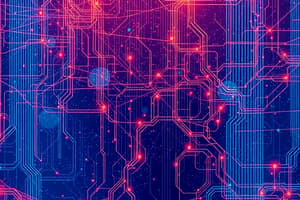Podcast
Questions and Answers
Which device performs the function of determining the path that messages should take through internetworks?
Which device performs the function of determining the path that messages should take through internetworks?
- A web server
- A firewall
- A DSL modem
- A router (correct)
Which criteria is typically used to help select a network medium from various options?
Which criteria is typically used to help select a network medium from various options?
- The cost of the end devices utilized in the network
- The environment where the medium is to be installed (correct)
- The types of data that need to be prioritized
- The number of intermediary devices installed in the network
Which statement best describes intermediary devices?
Which statement best describes intermediary devices?
- Intermediary devices are the primary source of data storage.
- Intermediary devices connect individual hosts to the network. (correct)
- Intermediary devices generate data content.
- Intermediary devices initiate the encapsulation process.
What is the main function of end devices on a network?
What is the main function of end devices on a network?
What type of network would an employee access to obtain confidential pricing information from internal servers at the Head Office?
What type of network would an employee access to obtain confidential pricing information from internal servers at the Head Office?
Which Internet connection option does not require physical cables to be run to the building?
Which Internet connection option does not require physical cables to be run to the building?
Which networking trend involves using personal devices to access resources on a business or campus network?
Which networking trend involves using personal devices to access resources on a business or campus network?
Which statement describes a characteristic of cloud computing?
Which statement describes a characteristic of cloud computing?
What statement best describes the role of network protocols?
What statement best describes the role of network protocols?
Why is it advantageous to use standards when developing protocols?
Why is it advantageous to use standards when developing protocols?
Which layers of the OSI model are comparable in function to the application layer of the TCP/IP model?
Which layers of the OSI model are comparable in function to the application layer of the TCP/IP model?
At which layer of the OSI model does IP address encapsulation occur?
At which layer of the OSI model does IP address encapsulation occur?
Which Protocol Data Unit (PDU) is handled at the transport layer of the TCP/IP model?
Which Protocol Data Unit (PDU) is handled at the transport layer of the TCP/IP model?
What is the primary function of Layer 4 in the OSI model?
What is the primary function of Layer 4 in the OSI model?
What term describes a unit of data at any layer of a networking model?
What term describes a unit of data at any layer of a networking model?
Which layer of the OSI model is responsible for physical data transmission?
Which layer of the OSI model is responsible for physical data transmission?
Which statement accurately describes powerline networking technology?
Which statement accurately describes powerline networking technology?
What are the minimum security requirements for a small office network?
What are the minimum security requirements for a small office network?
Which type of network traffic is most likely to require Quality of Service (QoS)?
Which type of network traffic is most likely to require Quality of Service (QoS)?
What is a characteristic of a scalable network?
What is a characteristic of a scalable network?
What communication method sends a message to all devices on a local area network?
What communication method sends a message to all devices on a local area network?
What process involves placing one message inside another for transmission?
What process involves placing one message inside another for transmission?
In what order does the protocol stack prepare a request for transmission from a web client?
In what order does the protocol stack prepare a request for transmission from a web client?
Which data protection goal is supported by implementing strong, complex passwords?
Which data protection goal is supported by implementing strong, complex passwords?
Which statement accurately describes the function of network protocols?
Which statement accurately describes the function of network protocols?
What advantage do standards provide in the development and implementation of protocols?
What advantage do standards provide in the development and implementation of protocols?
Which layers of the OSI model correspond to the application layer of the TCP/IP model? (Choose three.)
Which layers of the OSI model correspond to the application layer of the TCP/IP model? (Choose three.)
At which layer of the OSI model is an IP address encapsulated?
At which layer of the OSI model is an IP address encapsulated?
Which Protocol Data Unit (PDU) is associated with the transport layer of the TCP/IP model?
Which Protocol Data Unit (PDU) is associated with the transport layer of the TCP/IP model?
What primary function does Layer 4 of the OSI model serve?
What primary function does Layer 4 of the OSI model serve?
What is the general term used to describe a piece of data at any layer of a networking model?
What is the general term used to describe a piece of data at any layer of a networking model?
Which layer of the OSI model is responsible for ensuring that data is correctly delivered to the correct application?
Which layer of the OSI model is responsible for ensuring that data is correctly delivered to the correct application?
What type of network allows secure access to confidential resources from an external location?
What type of network allows secure access to confidential resources from an external location?
Which factor is least relevant when selecting a network medium?
Which factor is least relevant when selecting a network medium?
What is a common characteristic of a converged network?
What is a common characteristic of a converged network?
Which option for internet connection typically has high latency due to reliance on atmospheric conditions?
Which option for internet connection typically has high latency due to reliance on atmospheric conditions?
Which of the following best describes the role of intermediary devices in a network?
Which of the following best describes the role of intermediary devices in a network?
Which statement regarding the BYOD trend is accurate?
Which statement regarding the BYOD trend is accurate?
What is typically the primary purpose of a firewall in a network?
What is typically the primary purpose of a firewall in a network?
Which of the following is NOT a reason for implementing Quality of Service (QoS) in a network?
Which of the following is NOT a reason for implementing Quality of Service (QoS) in a network?
What is required to access cloud services?
What is required to access cloud services?
Which feature does not describe powerline networking technology?
Which feature does not describe powerline networking technology?
Which actions would provide the minimum security requirements for a small office network?
Which actions would provide the minimum security requirements for a small office network?
Which type of traffic is most likely to require Quality of Service (QoS)?
Which type of traffic is most likely to require Quality of Service (QoS)?
What is a key characteristic of a scalable network?
What is a key characteristic of a scalable network?
What process involves placing one message inside another message for transmission?
What process involves placing one message inside another message for transmission?
In which order should the protocol stack prepare a request for transmission from a web client?
In which order should the protocol stack prepare a request for transmission from a web client?
What data protection goal is primarily supported by strong, complex passwords?
What data protection goal is primarily supported by strong, complex passwords?
Flashcards are hidden until you start studying
Study Notes
Network Protocols
- Network protocols define the rules for exchanging messages between the source and destination.
- Standards are essential for protocol development as they facilitate interoperability across various manufacturers.
OSI Model
- The OSI model is divided into seven layers:
- Physical: Defines the physical connection and transmission medium.
- Data link: Provides reliable data transfer between two directly connected devices.
- Network: Responsible for logical addressing, path determination, and routing.
- Transport: Provides reliable data transfer and flow control between applications.
- Session: Manages communication sessions between applications.
- Presentation: Handles data format and encryption.
- Application: Enables users to access and utilize network resources.
TCP/IP Model
- The TCP/IP model consists of four layers:
- Application: Provides access to network services like email and web browsing.
- Transport: Handles end-to-end communication between hosts.
- Internet: Provides logical addressing and routing capabilities.
- Network Access: Handles physical layer communication.
PDU (Protocol Data Unit)
- A PDU is a piece of data processed at each layer of the OSI model, with each layer encapsulating the PDU from the layer above.
- Encapsulation is the process of adding header information to a data packet at each layer.
- De-encapsulation is the process of removing header information at each layer.
Intermediary Devices
- Intermediary devices connect end devices to the network, facilitate communication, and manage data flow.
- Examples include routers, switches, and firewalls.
End Devices
- End devices generate and consume data, and are responsible for tasks like accessing network resources and communication.
- Examples include computers, smartphones, printers, and servers.
Network Types
- Intranet: A private network within an organization for internal communication.
- Extranet: A network that extends an intranet to authorized external users.
- Internet: A global network connecting various networks and devices worldwide.
- Local Area Network (LAN): A network within a limited geographical area, like a home or office.
- Wide Area Network (WAN): A network spanning a vast geographical area.
Cloud Computing
- Cloud computing enables accessing services and applications via the internet, offering on-demand computing resources.
Powerline Networking
- Powerline networking enables devices to connect to the internet using existing electrical wiring.
Network Security
- Firewall: A device that filters incoming and outgoing network traffic, enhancing security.
- Antivirus software: A program that protects against malware.
Network Traffic Quality of Service (QoS)
- QoS is used to prioritize network traffic for specific applications, ensuring smooth performance.
Data Protection Goals
- Data integrity: Ensures accuracy and reliability of data.
- Data confidentiality: Protects data from unauthorized access.
- Data redundancy: Provides backup and disaster recovery.
Network Characteristics
- Scalability: A network's ability to grow and adapt to increasing demands.
- Reliability: The ability to handle failures and maintain network operations.
- Broadcast communication: Transmits data to all devices on a local network.
- Multicast communication: Sends data only to a specific group of devices.
- Unicast communication: Transmits data between a single source and single destination.
Protocol Stack
- The protocol stack defines the sequence of protocols used in data transmission.
- The order of protocol stack for a web request is typically:
- Ethernet: The network access layer.
- IP: The internet layer responsible for logical addressing.
- TCP: The transport layer ensuring reliable data transfer.
- HTTP: The application layer responsible for web communication.
Studying That Suits You
Use AI to generate personalized quizzes and flashcards to suit your learning preferences.




